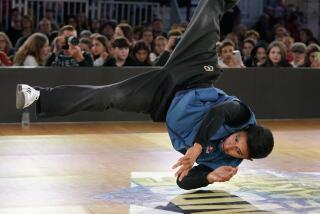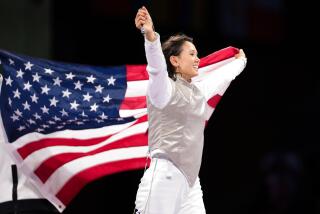The Right Touch : Fencing Is Physical, Intellectual, Romantic--and Utterly Relaxing
- Share via
On a Tuesday evening at Westside Fencing Center in Culver City, longtime fencing partners Marc Walch and Frank Fox meet for a go-round of foil.
In keeping with tradition, they pause to “test” weapons--a fleeting tap with the sword on the opponent’s chest. Next the salute: Each draws his foil to his chin, resting it lightly. With steel mesh masks pulled forward, the fighting begins.
What follows is the quick, subtle play of cat and mouse. The attack, parry, riposte, counterparry, fleche (sprint) and “touch” swiftly merge. A fencing director on the sidelines keeps score. In tonight’s first round, Fox--the first to score five points--is the winner.
Like Walch and Fox, athletes in clubs and schools throughout Southern California meet to share the many dimensions of this deadly combat skill that first developed into a popular sport in 14th-Century Europe.
While few here have taken the sport as far as these two (Walch placed 12th nationally in 1989; Fox has ranked among the top 16 for a number of years), those who get beyond the first year of learning the mechanics contend that the struggle is well worth it.
“It takes a lot of patience to learn,” says Walch, 36, whose training began at age 11 in France.
“You fence with literally a thousand different actions, and it takes a lifetime to learn them all,” says the 6-foot electrical engineer who once a week matches wits with Fox and other veteran swordsmen.
“Fencing helped me to discover who I am . . . It uses so much of you. Not just physically but also intellectually,” he says. “Once you start having successes or defeats, you know what you can or cannot do.”
Fueled by the same passions, the shorter and lighter Fox, a 29-year-old attorney, fences nightly. His education in the sport began when he was an 11-year-old student in Culver City.
“The biggest problem is that I don’t have top-level fencers to compete with. When I get Marc I’m thrilled. In Europe, you have a tournament every week in a nearby town or country, and the best go to tournaments,” Fox says.
Learning to adjust the body to an asymmetrical form becomes the first step of a fencer. One arm is thrust forward while the other is thrown back; one foot points forward, the other to the side. A perfectly balanced body travels on flexed legs, a motion that suggests the ballet. A year may pass before a student becomes comfortable with the motions of fencing.
“In the beginning, you feel a lot like a duck juggling,” says Bill White, 45, an insurance executive who has been studying with Jack Akopyan at Los Angeles Athletic Club for the past two years.
“You know you’ve arrived when you’re not thinking about every movement. It’s just happening.”
The profuse sweat produced in a six-minute-or-less bout results from an intense collaboration of mind and body to achieve “the touch.”
“The physical content of the game is quite vast,” says Ted Katzoff, director of Westside Fencing Center and a UCLA fencing coach. “You’re using most of the muscle groups in the body, either on an isolated basis or in synchronization. It’s not like an aerobics class, which has you constantly bouncing up and down.”
Ideally, a fencer spends from 40% to 60% of the time in blade and footwork drills and 20% to 40% in combat practice. Such ratios develop hand-eye coordination.
“The constant mobility, change of motion, change of tempo over a period of time will tend to develop stamina, strength and physical discipline,” says Katzoff.
Age is only a minor consideration. A good example is 72-year-old Maxine Mitchell of Fontana, a four-time Olympian who won a gold medal at the Pan American Games in 1955 and retired from fencing a year-and-a-half ago after a hip transplant and a career that spanned 41 years.
“They used to tease me because I hadn’t lunged for the last 10 years,” Mitchell recalls. “You actually set your opponent up and make him come to you. When your legs go, you start using your head.”
Fencing is sometimes compared to chess at 90 m.p.h., or to a high-speed video game. Any way you look at it, the play is fast. In the past 20 years, the increased speed of the game has called for electronic wiring of fencers in order to judge touches accurately. The fencers wear metallic cloth vests. Wires attached to each fencer’s weapon are connected to the scoring box. A touch closes the circuit and causes colored lights to flash. Bouts are supervised by a director who applies the rules and awards the touches.
Each of the three weapon styles--foil, epee (pronounced epp-pay) and saber--determine how the game is played.
The foil is a modern version of the original training weapon. Touches are scored with the blunted tip on only the trunk of the body. The epee, too, is a point weapon, but whoever hits first, anywhere on the body, scores the touch. With the saber, a cut-and-thrust weapon, the entire upper body is a valid target area.
Ed Richards, 59, has had a competitive fencing career that includes three Pan Am teams, three world-championship teams and one Olympic team (Tokyo ‘64).
“People think this is a thinking sport. It is. But the thinking is subconscious,” he says. “I’ve seen people lose bouts because they are thinking about what to do next. While you are thinking, the other guy hits you.”
What is not underestimated, however, is an alert savvy that guides the choices a fencer makes at every turn.
“Fencing is a liar’s game,” Richards says. “I’m not going to accommodate you. I’m going to show you one thing, and when you really come, I’m going to do something else.”
Although 24 fencing medals are a significant statement of the sport’s importance to the Olympics, the game has always had a negligible impact on the American sporting scene. It is not surprising that the results achieved by U.S. fencers at the ’88 Olympics in Seoul, Korea, went largely unnoticed in a country preoccupied with gold medals.
But when one considers that gold medals usually are won by countries that subsidize their athletes, the U.S. results were very positive, says Beverly Hills producer Carl Borack, captain of the U.S. Olympics team in ’88 and captain of the U.S. world championship team.
Worth noting, Borack says, was the sixth place captured by the U.S. women’s team. So was the 11th place claimed by Kaitlin Bilodeaux of Montreal (fencing for the United States) in women’s foil individual and the 12th place by Peter Lewison of Brooklyn in men’s foil individual.
“You can’t be a weekend or part-time fencer and compete with the top of the world,” Borack says. “But given the fact that our athletes are truly amateurs, these are extraordinarily good results.”
In Culver City, the sign-up sheet for Al Couturier’s Tuesday-night fencing lessons will probably keep him on his feet until midnight, but he doesn’t mind. By fencing, the 5-foot silver-haired master recovered from the effects of osteomyelitis, a childhood disease that had severely weakened his legs. He can’t move about as quickly as some, but his mastery of handwork technique has turned Couturier into a legend in the fencing world. Many nights, his students say, “no one can get near him.”
“Fencing has kept me very healthy,” Couturier says. His salle (club) also boasts the women’s national epee champion. And, he proudly declares, fencing “has also kept me from getting so stiff in my knees from arthritis that I would otherwise be walking on crutches. I’m 67 years old and this is my 25th year in teaching. I expect to be going until I’m 97.”
At the gymnasium of the Los Feliz Jewish Community Center, where members of the Los Angeles Fencer’s Club meet, club coach George Radai and partner Chris Howell direct a program for high school fencers that was originally funded by the Amateur Athletic Foundation of Los Angeles after the 1984 Summer Games
Looking out onto the gymnasium floor bustling with boys and girls, Radai says: “Our students have been very happy with themselves because their performances have been so good. I went to a couple of these high school tournaments just to observe them fence. Some of them would come up to me and go, ‘I have to fence this guy and I lost to him before. What should I do? What should I do?’ I would say, ‘First thing you should do is not do what you did before. Right? Change your strategy.’ ”
Beyond the physical, intellectual and romantic aspects of fencing, there is something else--something that has always appealed to Steve Goldman, 50, founder of the Venice Fencing Club.
Once the No. 1 epee man on a small New England college NCAA team for three years running, Goldman explains: “As strenuous as fencing is, and as much concentration as it needs, it is utterly relaxing. It’s a way of getting out of yourself and responding. Because the world goes away. It’s a kind of mutual meditation. I call it meditations in steel.”


